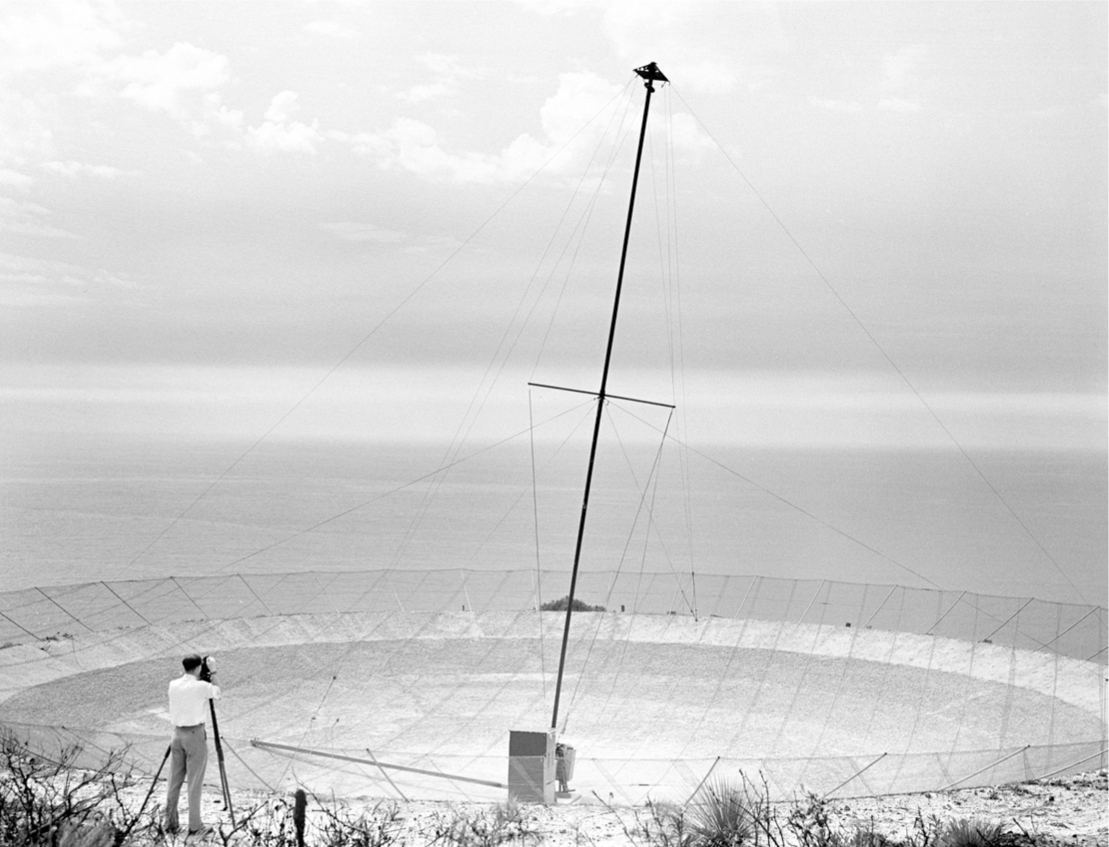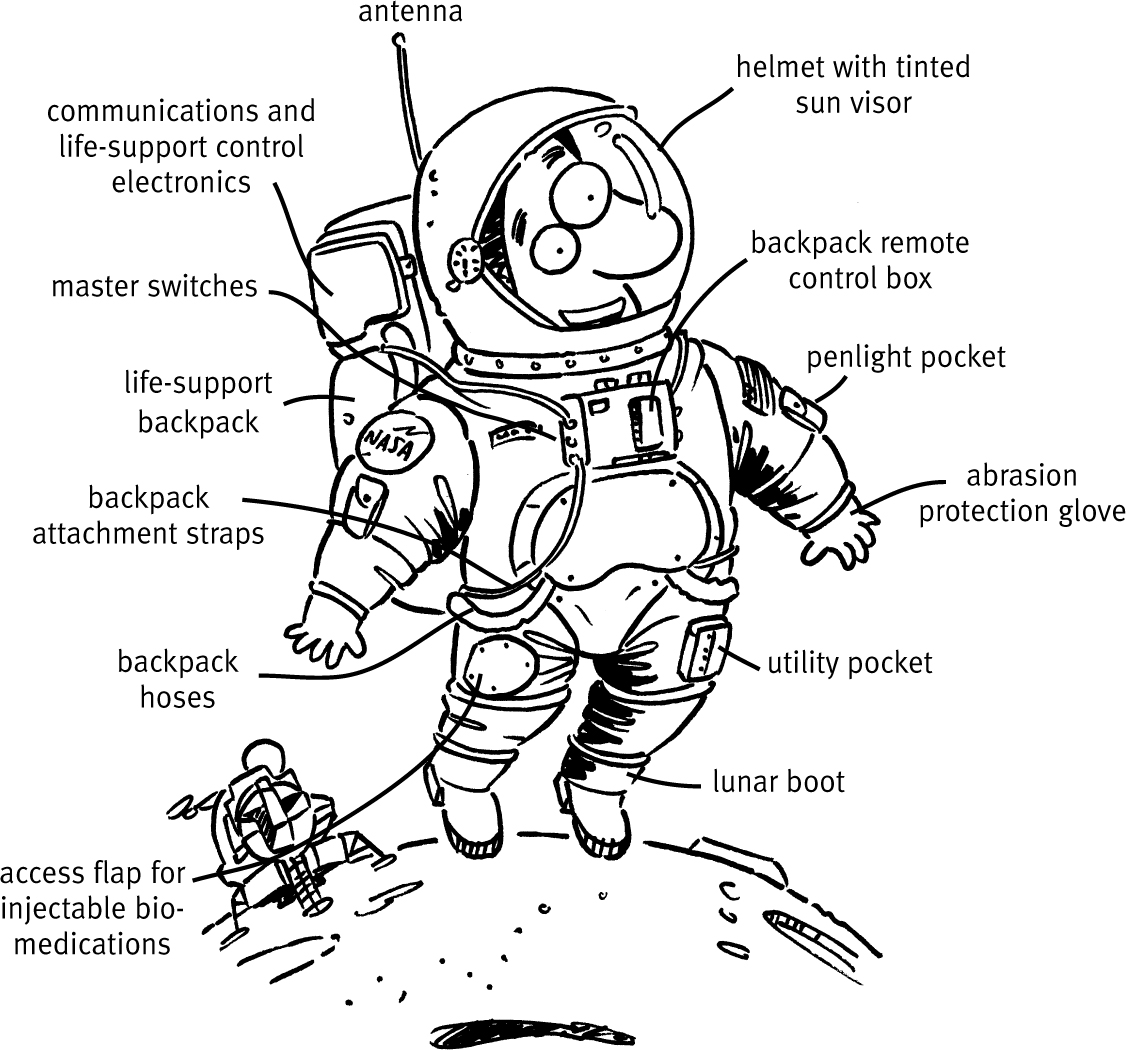Australia Gazes at the Universe
Why were there tracking stations for the American Space Program in Australia? Because NASA needed to keep in touch with its spacecraft all the time — and this couldn’t be done from just one place on Earth. NASA needed tracking stations across the world. (For a short time Australia was also one of the three major players in space exploration.)
In 1947 Australia was one of the first countries to really study the Moon’s surface with a new invention called radar — short for radio detecting and ranging. Scientists at the new CSIRO (Commonwealth Scientific and Industrial Research Organisation) analysed echoes from radar signals bounced off the Moon’s surface and worked out that the Moon was made of rock and gravel covered by about two centimetres of very fine dust.
Australia didn’t have the available money that the United States and Great Britain did for science or space exploration. But we had incredible ingenuity!
Our home-made ‘Dish’
In 1946 John Bolton — who went on to become the director of the CSIRO’s big radio telescope in Parkes — Bruce Slee, and later Gordon Stanley, were monitoring the newly discovered radio emissions from the Sun at the wartime coastal radar station at Dover Heights just south of Sydney Harbour. Their home- made radio telescope was one of the most powerful in the world — even though it was made from spare parts left over from World War II.

The Dover Heights ‘dish’, taken in 1953. Known as the ‘hole-in-the-ground antenna’, it was used with outstanding success to survey radio emissions from the Galactic plane.
© CSIRO, ATNF PHOTO ARCHIVE B3150-2
At one stage the Sun was going through a quiet phase and the men got bored, so they began to hunt for other objects that might emit radio waves — the giant bursts of radio-energy waves from sunspots and solar flares. They were among the first to observe radio emissions from galaxies beyond our own.
These men wanted more — a radio telescope that was more sensitive and could operate on a greater range of frequencies. But there was no money, no equipment — so again, they made their own.
As they didn’t have permission from their supervisor — at what was now the Dover Heights Radiophysics Field Station — the men spent their lunch hours, in secret, digging a huge hole in the ground. It took them three months to dig a hole 21.9 metres across. They packed down sand to make the hole a perfect ‘dish’ shape, then brought ash from a nearby power station to make the surface as smooth as they could and scavenged steel ties from packing cases.
They’d built the world’s second largest ‘dish’ from dirt and rubbish. Because it couldn’t move, it could only monitor the strip of sky that passed above it as Earth rotated. The dish in the ground — later made even larger with concrete and chicken wire — was the first to pinpoint the very heart of our galaxy, the centre around which all stars rotate.
(If you go to the Rodney Reserve at Dover Heights in Sydney now you’ll walk over the radio telescope in the sports ground. It’s just past the northern goalpost of the football field, covered by soil and grass. There is a small plaque nearby which tells the historic story.)
Woomera and the first satellite
Australia wasn’t just gazing into outer space, we were heading up there too — we were the fourth country in the world to launch our own home-made satellite — WRESAT in 1967. Australian rockets like the Long Tom, designed for high altitude research, were launched from Woomera in South Australia, where guided missiles for the British and Australian military were also tested.
British rockets like the Skylark, Black Knight and Blue Streak travelled hundreds of kilometres across the central Australian desert, tracked by dozens of down-range instrumentation facilities.
Australian engineers designed, built and flight-tested a remote-controlled pilotless jet aircraft called Jindivik — over 500 Jindiviks were sold to the United States, Great Britain and Sweden.
Australia also designed and built a guided missile called Ikara, which carried and dropped a miniature homing torpedo near submarines — a major breakthrough in anti-submarine warfare.
Why did it all stop? Money. Australia was committing more troops to the Vietnam War — war is expensive, and so is space research. It was no longer a case of spare parts and leftover equipment from World War II, aided by a lot of talent and enthusiasm. Great Britain pulled out of Woomera — the Americans were so far ahead now that the British had no chance of competing with them — and Australia lost another source of money.
For a long time the once vast launch pads and tracking facilities were left abandoned to the desert sands. But Woomera is no longer a ghost town. It has been selected by the Japanese as the site for landing tests of their prototype space shuttle, as well as test- firings of the University of Queensland’s HyShot scramjet.
Space tracking
Australia already had NASA tracking stations, to track new small satellites that orbited Earth and also to look into deep space. In the late 1950s and early 1960s, Australians at the Space Tracking and Data Acquisition Facility at Orroral Valley in the ACT were working around the clock tracking lots of small Earth-orbiting satellites: Explorer 1 in 1958, that discovered Earth’s Van Allen radiation belt (the geomagnetically charged particles circling Earth in line with Earth’s magnetic field) and detected cosmic rays; Tiros 1 in 1960, that studied Earth’s weather patterns; Echo 1 in 1960, that relayed the first radio and television pictures from space; Telstar 1 in 1962, that broadcast radio and TV programs; and OAO-2 in 1968, the first orbiting astronomical observatory.
There were deep-space tracking stations too: Island Lagoon at Woomera tracked Ranger from 1961 to 1965, as it took the first close-up photos of the lunar surface, and Mariner 4, in 1964, undertook the first deep-space mission to Mars.
The Muchea Tracking Station, north of Perth, helped track the 1962 flight of John Glenn — in the spacecraft Friendship 7 — who became the first American to orbit Earth. On that flight Perth and Brisbane were the only cities on the ‘night’ side of Earth that the spacecraft would pass over. Almost every household in Perth and Brisbane left their lights burning all night, in the hope that John Glenn would see them from space.
There was to be a new stage in Australia’s part in the exploration of the universe beyond Earth — the new tracking station at Honeysuckle Creek, built to track manned spacecraft as they travelled to the Moon.
WHAT DOES IT TAKE TO BECOME AN ASTRONAUT?
In the early years of space exploration no-one knew what kind of conditions astronauts would be subjected to in outer space. Would their bones turn to jelly? Would they be able to eat and drink in the weightlessness of zero gravity? Would being cramped in a confined space for lengthy periods of time in a spacecraft send them insane?
To become an astronaut, candidates had to pass incredible physical and psychological tests. They had to be under the age of 36, weigh no more than 81.6 kilograms, be incredibly fit and strong, and small enough to fit inside a space capsule. They had to have patience to endure long periods of inactivity, while constantly being on the alert, in order to respond and act quickly if any problems arose. They also had to be able to survive in all types of terrain: the ocean, the desert and the jungle.
Astronauts had to have university degrees in engineering or the physical sciences and had to have studied some science subjects including meteorology, geology, astrophysics, aeronautics and aviation. They had to be qualified test pilots so that they could take over flying a spacecraft if the automatic systems failed. It was also important that they understood each part of a spacecraft — how it worked and how to operate it.
Incredible force is required for a rocket to fire up enough power to escape Earth’s gravity. Astronauts would have to withstand enormous pressures on their bodies during lift-off and re-entry. Could they survive this? Was there any way to protect them?
Yes. Astronauts could be fitted with pressure suits and sit in contoured couches — but they would still have to be able to stay conscious and, if necessary, take over the navigation and system controls in an emergency at up to 16 times the normal gravity of Earth. To do this astronauts spent hours in centrifuges, being spun at enormous speeds to mimic conditions (including the G-forces) they would have to endure in space.

Nowadays, with improved spacecraft design, astronauts only have to tolerate about three gravities — although they still have to endure the incredible vibration at lift-off.
In the early days, astronauts had to be everything and be prepared for anything, as no-one yet knew what they would have to face.